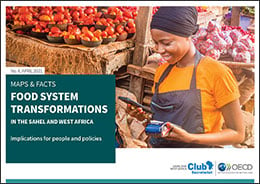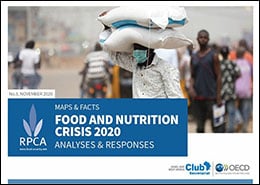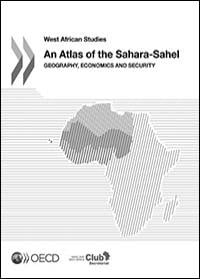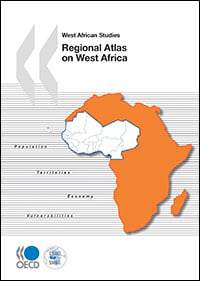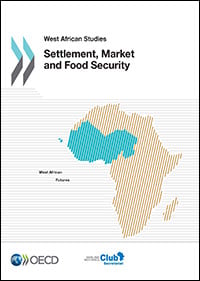The SWAC Secretariat's map library includes over 400 maps and nearly 100 figures.
The maps are without prejudice to the status of or sovereignty over any territory, to the delimitation of international frontiers and boundaries and to the name of any territory, city or area. We encourage the use of our maps. Please include the SWAC’s copyright, inform or contact us for specific requests: [email protected]
Maps & Facts
2022
- No. 111, Cross-border transhumance challenged by security measures | pdf
- No. 110, One-third of West African children under the age of five are stunted | pdf
- No. 109, Women in the food economy in the Sahel and West Africa | pdf
- No. 108, A major food and nutrition crisis for the third consecutive year | pdf
- No. 107, Financing for Gender Equality in West Africa | pdf
2021
- No. 106, Population growth in the Sahel versus North Africa | pdf
- No. 105, The ECOWAS area facing the 2021 food and nutrition crisis | pdf
- No. 104, The UEMOA area facing the 2021 food and nutrition crisis | pdf
- No. 103, Niger's presidential election | pdf
- No. 102, Women and conflict | pdf
- No. 101, Gender disparities in trade networks | pdf
2020
- No. 99, West Africa makes face mask use compulsory | pdf
- No. 98, Social safety spending remains too low | pdf
- No. 97, More than one-third of West Africans have no handwashing facility at home | pdf
- No. 96, Urban agglomerations in the UEMOA area | pdf
- No. 95, Urban agglomerations in the ECOWAS area | pdf
- No. 94, The growing potential of the UEMOA food economy | pdf
- No. 93, The growing potential of the ECOWAS food economy | pdf
- No. 92, Severe food insecurity has doubled in the ECOWAS area | pdf
- No. 91, Severe food insecurity has tripled in the UEMOA area | pdf
- No. 90, Dangerous border areas | pdf
- No. 89, UEMOA economies are projected to grow by 6.6% in 2020 | pdf
2019
- No. 88, More than twice as many severely food insecure people | pdf
- No. 87, Doing business in West Africa is getting easier, notably in Togo | pdf
- No. 86, Increasing inequality in the Sahel and West Africa | pdf
- No. 85, Urban development assistance mostly benefits big cities | pdf
- No. 84, African plans for a trans-continental road network | pdf
- No. 83, Health coverage in West Africa | pdf
- No. 82, The African Continental Free Trade Area (AfCFTA) | pdf
- No. 81, Africa's border agglomerations | pdf
- No. 80, Official development assistance to West Africa | pdf
- No. 79, Food and nutrition situation | pdf
- No. 78, Women suffering from anaemia - a major challenge | pdf
- No. 77, Voter turnout in West Africa | PDF
- No. 76, West Africa’s growth prospects remain strong | pdf
- No. 75, Polygamy remains common and mostly legal in West Africa | pdf
2018
- No. 74, West Africa's food security outlook for 2019 | pdf
- No. 73, The growing issue of over-nutrition in West Africa | pdf
- No. 72, Chinese loans to West African governments | pdf
- No. 71, Military expenditures in West Africa | pdf
- No. 70, Violent extremism in the Sahara-Sahel | pdf
- No. 69, Press freedom in West Africa: Ghana best | pdf
- No. 68, Rural employment diversification | pdf
- No. 67, Critical food and nutrition situation in the Sahelian belt | pdf
- No. 66, Stereotypes impede women's access to employment | pdf
- No. 65, Transhumance and nomadism | pdf
- No. 64, The G5 Sahel and its joint force | pdf
- No. 63, Burkina Faso still has a long way to go on gender equality | pdf
2017
- No. 62, Liberia’s 2017 presidential election | pdf
- No. 61, Food and nutrition situation in the Sahel and West Africa | pdf
- No. 60, Global Hunger Index confirms West Africa’s progress | pdf
- No. 59, Substantial food price gaps across West Africa | pdf
- No. 58, Urban-rural linkages and the emergence of new urban agglomerations | pdf
- No. 57, Benin, Niger & Nigeria: A strong potential for co-operation | pdf
- No. 56, Visa oppeness facilitates free movement of people in Africa | pdf
- No. 55, Market potential of West African agglomerations | pdf
- No. 54, Nigeria’s recession slows down West African economy | pdf
- No. 53, Food and nutrition situation in Nigeria | pdf
- No. 52, Satellite towns: Benefiting from proximity | pdf
- No. 51, Food and nutrition situation, March-August 2017 | pdf
- No. 50, Women in parliament: Senegal ranks 7th worldwide... | pdf
- No. 49, Corruption remains a key challenge for West Africa | pdf
- No. 48, The six regions of the African Union | pdf
- No. 47, Cross-border co-operation potential of West Africa | pdf
2016
- No. 46, National Resilience Priorities (NRP-AGIR) | pdf
- No. 45, Eight million people in northern Nigeria facing acute food insecurity | pdf
- No. 44, One out of three people in northeastern Nigeria faced with acute food insecurity | pdf
- No. 43, Some signs of better governance in West Africa | pdf
- No. 42, Internet: West Africans are going mobile but many are still offline | pdf
- No. 41, The Regional Food Security Reserve | pdf
- No. 40, Malnutrition persists | pdf
- No. 39, West Africa’s economy stalled in 2015, gradual recovery in 2016 | pdf
- No. 38, An overall good agro-pastoral campaign but malnutrition persists | pdf
- No. 37, Sahelian migration within the region | pdf
- No. 36, Rural and urban populations are moving closer together | pdf
- No. 35, Nearly 30% of West Africans lack access to an improved water source | pdf
- No. 34, Surface water in Africa | pdf
- No. 33, West African girls are being married off too young | pdf
- No. 32, Major nomadic groups | pdf
- No. 31, Ebola killed more than 11 000 people | pdf
2015
- No. 30, Female genital mutilation/cutting (FGM/C) | pdf
- No. 29, Food and nutrition situation - December 2015 | pdf
- No. 28, Burkina Faso: presidential and legislative elections | pdf
- No. 27, Main infrastructure projects planned for northern Mali | pdf
- No. 26, Rainfall evolution | pdf
- No. 25, Progress towards achieving food security | pdf
- No. 24, Food and nutrition situation: June-Aug 2015 | pdf
- No. 23, Togo's presidential election | pdf
- No. 22, Nigeria's presidential election | pdf
- No. 21, Sahara-Sahel empires and their routes | pdf
- No. 20, Western Sahara | pdf
- No. 19, Niger: internal fragility and external threats | pdf
- No. 18, Violent events (1997-2012) | pdf
- No. 17, Limits of the Sahara-Sahel | pdf
- No. 16, Borders in the Sahara-Sahel | pdf
- No. 15, Cigarette trafficking | pdf
- No. 14, Population density in the Sahara | pdf
- No. 13, Migratory movements | pdf
- No. 12, Communication networks in northern Mali | pdf
2014
- No. 11, Population in northern Mali | pdf
- No. 10, Poverty in northern Mali | pdf
- No. 09, Decline of the nomadic population | pdf
- No. 08, Tourism in the Sahara-Sahel | pdf
- No. 07, Cocaine flows | pdf
- No. 06, Hashish flows | pdf
- No. 05, Boko Haram | pdf
- No. 04, Niger: internal fragilities & regional threats | pdf
- No. 03, Trans-Saharan road gap | pdf
- No. 02, Trans-Saharan Gas Pipeline | pdf
- No. 01, Oil in Niger | pdf
Food system transformations in the Sahel and West Africa
Food systems are central to our lives, our well-being and our societies. This is particularly true in the Sahel and West Africa, where the majority of the population makes its living from food-related activities. However, food systems around the world are facing a triple challenge (food and nutrition security, livelihoods and environmental sustainability). This Maps&Facts issue provides an overview of some of the main issues of food system transformations in the Sahel and West Africa and implications for people and policies in the region.
Food and Nutrition Crisis 2020: Analyses & Responses
This “Maps & Facts” brochure looks at the food and nutrition crisis of 2020 which will undoubtedly be remembered as one of the most serious in recent decades. Behind the figures that the reader will come across in this brochure there are lives at risk, women in distress, and children whose stunted growth is compromising their prospects of leading a dignified life. All serious threats to the future.
Download the full document.
Food issues: demographic, urban, migration and security challenges
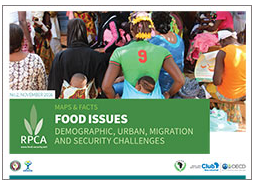 Preview | PDF | PowerPoint | Maps | Figures | Tables
Preview | PDF | PowerPoint | Maps | Figures | Tables
This “Maps & Facts” brochure looks at the demographic, urban, migration and security challenges in the Sahel and West Africa through the lens of food issues. It promotes the following key message: the challenges facing food security should not be overshadowed by the resurgence of demographic, migration and security concerns on the international agenda. Rather, food security is closely related to these issues, and should be considered as part of the solution to the challenges they raise. Food issues are at the heart of the West African economy and society; ignoring their importance would be a strategic error. The business of making food for human consumption, including all elements of the value chain – production, processing and distribution – is the largest sector in the region, far ahead of oil, cash crops or industry. The food sector is key for creating more jobs, stimulating stronger and more inclusive growth, opening up a wider field of opportunities for agricultural producers and other entrepreneurs, and pulling the most vulnerable out of poverty and insecurity. Food issues must therefore remain at the centre of all reflection, policy and action – from food crisis prevention, to economic development, to building the resilience of the most vulnerable people.
You can download the full document, copy and paste maps from the PowerPoint presentation or download individual maps from the SWAC Online Map Library:
- Map 1: Progress towards achieving food security
- Map 2: Prevalence of stunting (% of children, 0-5 years)
- Map 3: Percentage of young women (20-24 years) married before age 18
- Map 4: Levels of urbanisation
- Map 5: Urban agglomerations with more than 10 000 inhabitants
- Map 6: Rural density and urban networks
- Map 7: West African emigration within West Africa, 2015
- Map 8: Regional maize flows
- Map 9: Places of residence of Sahelian emigrants, 2015
- Map 10: Internally displaced persons (IDPs) in Africa, 2015
- Map 11: Refugees and internally displaced persons linked to current or recent conflicts
- Map 12: Food insecurity in north-eastern Nigeria, October-December 2016
- Map 13 Niger: Internal fragilities & regional threats
- Map 14: Chad: Internal fragilities and regional threats
- Map 15: National Resilience Priorities (NRP-AGIR)
- Figure 1: West African population, 1950-2050
- Figure 2: Food supply from domestic production
- Figure 3: Prevalence of undernourishment
- Figure 4: Birth and death rates in West Africa
- Figure 5: Rural and urban populations in West Africa, part 1
- Figure 5: Rural and urban populations in West Africa, part 2
- Figure 6: Share of regional food GDP by country, 2010
- Figure 7: Manufacturing activities in Senegal, 1980-2010
- Figure 8: Urbanisation and fertility
- Figure 9: Distribution of household food consumption, 2010
- Figure 10: West African migrants in the world
- Figure 11: Country of origin of West African migrants in Europe
- Figure 12: Distribution of West African emigrants, 2015
- Figure 13: Migrant remittances, % of GDP, 2014
- Figure 14: PREGEC cycle: food crisis prevention and management
- Figure 15: Food value chain
Atlas of the Sahara-Sahel
The Atlas | Maps: Preface+Chapter 1 | Maps: Chapters 2-10 | Visualise Maps | Online Map Library
The following maps are extracted from the OECD publication "An Atlas of the Sahara-Sahel, Geography, Economics and Security", published in December 2014.
The 250‑page publication is illustrated with 105 maps. It addresses security challenges in the Sahara-Sahelian area by considering the mobility of its territories and populations in conjunction with the socio-economic networks that connect them. Given that the inhabitants are concentrated along roads and in towns (most people living in the Sahara-Sahel are urbanites), the Sahara-Sahel is neither empty nor immobile. The roads and towns form the framework of this area associated with mobile societies that are organised on the basis of social and trade networks more than ties to the state. The movement of people and goods within that framework — associated with nomadism, transhumance, trade and migration, but also with trafficking and violence — is the main focus of the Atlas.
You can copy and paste maps directly from the PowerPoint presentation (Part 1 | Part 2) or download individual maps by making a right click and choosing the option "save image as". You can also explore all SWAC maps in different formats by key word, topic or country search on the SWAC Online Map Library.
Preface
Chapter 1
- Map 1.1: Relief and hydrography
- Map 1.2: The arid area
- Map 1.3: The partition into administrative subdivisions
- Map 1.4: The partition into nation states
- Map 1.5: Variability of isohyets
- Map 1.6: The Sahel, zone of uncertainty
- Map 1.7: Variation in isohyets between 1940–1967 and 1968–2000
- Map 1.8: Coefficient of variation for annual precipitation, 1901–2006
- Map 1.9: The Paleo-Sahara
- Map 1.10: The impossibility of choosing a limit
- Map 1.11: Precolonial routes
- Map 1.12: The road network
- Map 1.13: City population
- Map 1.14: Cities in West Africa, 2010
- Map 1.15: The weight of history
- Map 1.16: Kanem Bornu
- Map 1.17: Almoravid and Almohad Empires
- Map 1.18: Ghana, Mali and Songhay Empires
- Map 1.19: Hinges of the Saharan region
- Map 1.20: Route empires
- Map 1.21: Border negotiations
- Map 1.22: Colonial empire limits in 1914
- Map 1.23: The process of independence
- Map 1.24: Population distribution
- Map 1.25: Population densities
- Map 1.26: Linear density of population
- Map 1.27: The impossible map (anamorphosis using inverse population density)
- Map 1.28: Mines and industries
- Map 1.29: Hydrocarbons
- Map 1.30: Metals and minerals
- Map 1.31: Petroleum license blocks
- Map 1.32: Agricultural production systems
- Map 1.33: Water, oases and breeding
- Map 1.34: The evolution of migration
- Map 1.35: Outsourcing of European migration policies
- Map 1.36: Migrants in Tamanrasset
- Map 1.37: The enclave of Ceuta
- Map 1.38: Migratory movements
- Map 1.39: Routes of the Paris-Dakar Rally
- Map 1.40: Touristic attractions
- Map 1.41: Touristic sites and routes
- Map 1.42: Violent events by type between 1997 and 2012
- Map 1.43: Violent events between 1997 and 2012
- Map 1.44: Victims of violence between 1997 and 2012
- Map 1.45: The actors in conflicts in 2012
- Map 1.46: Violent events by type in 2012
- Map 1.47: Areas reported on by the French Ministry of Foreign and European Affairs
- Map 1.48: Violent events in 2012
Chapter 2
Chapter 3
Chapter 4
- Map 4.1: Trans-Saharan commerce according to Monod’s circulation zones
- Map 4.2: Trans-Saharan routes in the Middle Ages
- Map 4.3: Sahelian empires and their routes
- Map 4.4: Exploration itineraries 1770–1890
- Map 4.5: Trans-Saharan projects before independence
- Map 4.6: The OCRS and its hoped-for resources
- Map 4.7: Regional co-operation institutions
- Map 4.8: Morocco’s commercial expansion in Africa
- Map 4.9: Complementary economies?
- Map 4.10: The trans-Saharan road gap
Chapter 5
- Map 5.1: The opening up of the Algerian territory
- Map 5.2: The role of Algeria’s Adrar rest stop
- Map 5.3: Migratory itineraries
Chapter 6
- Map 6.1: Transhumance and nomadism in Sahelian countries
- Map 6.2: Transhumance and its adaptation to isohyets
- Map 6.3: Livestock systems in Mali
- Map 6.4: Major nomadic groups
- Map 6.5: Chad’s nomadic population
Chapter 7
- Map 7.1: Border agglomerations, 2010
- Map 7.2: Border agglomerations with over 100 000 inhabitants, 2010
- Map 7.3: The working of border markets
- Map 7.4: West African border markets and Saharan border agglomerations
- Map 7.5: Border markets and potential cross-border functional region, 2010
- Map 7.6: Intergovernmental organisations, 2013
- Map 7.7: Sahara-Sahelian borders
Chapter 8
- Map 8.1: Chadian wars, 1964–2000
- Map 8.2: The advancement of the wall in Western Sahara, 1980–1987
- Map 8.3: Violent events between 1997 and 2012
- Map 8.4: An-Nahda electoral results in October 2011
- Map 8.5: Boko Haram
- Map 8.6: The ephemeral Azawad
- Map 8.7: Poverty in Mali
- Map 8.8: The truncated perception of ethnic groups in Mali
- Map 8.9: GSPC’s spatial organisation
- Map 8.10: Location of incidents by terrorist group, 2003–2012
- Map 8.11: Communications network in northern Mali
- Map 8.12: The risk of Libyan explosion
- Map 8.13: Military expenditures
- Map 8.14: Chad faced with regional threats
- Map 8.15: Mauritania between the Maghreb and the Sahel
- Map 8.16: Niger faced with regional threats
- Map 8.17: African peace and security architecture
- Map 8.18: International initiatives
Chapter 9
- Map 9.1: Major seizures of illicit weapons
- Map 9.2: Cigarettes’ long march
- Map 9.3: Cocaine seizures from 2005 to 2011
- Map 9.4: Cocaine flows
- Map 9.5: Hashish flows
Chapter 10
Regional Atlas on West Africa
The Regional Atlas | Maps - Part 1 | Maps - Part 2 | Visualise Maps | Online Map Library
The following maps are extracted from the OECD publication "Regional Atlas on West Africa", published in July 2009.
Recent global changes have placed regional integration at the centre of Africa’s political and economic agenda. This Atlas is both a driver and the result of strategic thinking on regional integration in West Africa. Containing maps, statistics and analyses, it describes the West African region, its population, settlement, territories, its economy and its vulnerabilities. It analyses the developments and the ways in which West Africa is conforming to a constantly changing global environment. The Atlas is a compilation of chapters, which were jointly published by the SWAC Secretariat and the ECOWAS Commission. It aims to increase understanding of regional integration dynamics in West Africa and thereby hopes to facilitate the building of a regional space in West Africa.
You can copy and paste maps directly from the PowerPoint presentation (Part 1 | Part 2) or download individual maps by making a right click and choosing the option "save image as". You can also explore SWAC maps in different formats by key word, topic or country search on the SWAC Online Map Library.
Part 1: Population and settlement
- Map 0.1: Population density in West Africa (2000)
- Map 0.2: Expansion of the areas of urban market attractiveness (1960–1990–2020)
- Map 1.1: Distribution and evolution of the world population in 2007
- Map 1.2: Evolution of the world urban population
- Map 1.3: Distribution and evolution of the West African population
- Map 2.1: Trend forecast for life expectancy at birth
- Map 2.2: Infant mortality in Africa
- Map 2.3: Incidence rate of measles (2006)
- Map 2.4: Number of malaria cases (2005)
- Map 2.5: Aids prevalence in West Africa (adults)
- Map 2.6: Tuberculosis prevalence per 100 000 inhabitants (2004)
- Map 3.1: Major African language families
- Map 3.2: Languages spoken by more than one million native speakers in 2005
- Map 3.3: Common languages
- Map 4.1: Migrants by continent (1960-2000)
- Map 4.2: Number of migrants in Africa
- Map 4.3: Major host countries in Europe (1993)
- Map 4.4: Major host countries in Europe (2000)
- Map 4.5: Major West African countries of immigration (1976–1980)
- Map 4.6: Major West African countries of immigration (1988–1992)
- Map 4.7: Movements by West African refugees (2005)
- Map 4.8: Evolution of the population in Europe and Africa
- Map 4.9: West African migration to Europe and the United States (2000)
- Map 4.10: Maghreb and West African migration
Part 2: Territories
- Map 5.1: Degree of rurality in West Africa
- Map 5.2: Agro-climatic conditions
- Map 5.3: Rural settlement in West Africa (2005)
- Map 5.4: Production systems in West Africa
- Map 5.5: Environmental constraints in the coastal area of the Gulf of Guinea
- Map 5.6: Forest cover in Africa (2005)
- Map 5.7: Rainfall in West Africa
- Map 5.8: Variation in potential biomass production in West Africa
- Map 5.9: Cereal and cattle trade in West Africa
- Map 5.10: Fresh tomato trade
- Map 5.11: Palm oil trade in Sénégambie méridionale
- Map 5.12: Irrigation intensity in Africa
- Map 6.1: West African bio-climatic zones
- Map 6.2: Transboundary watercourses in West Africa
- Map 6.3: Main transboundary aquifer systems in West Africa
- Map 6.4: Population densities in West African river basins
- Map 6.5: Large dams in West Africa
- Map 6.6: Migration of populations with the shrinking of Lake Chad
- Map 6.7: Bilateral agreement along the Niger river
- Map 7.1: Transport infrastructure in West Africa (2005)
- Map 7.2: Main paved or partially improved roads within ECOWAS
- Map 7.3: Practicability of some roads in West Africa (2005)
- Map 7.4: Port traffic in West Africa excluding oil terminals (2003)
- Map 7.5: Transit and re-export corridors in ECOWAS
- Map 7.6: Impact of the Ivorian crisis on cotton export corridors
- Map 7.7: Railway and merchandise transport in West Africa
- Map 7.8: Existing and planned railways in West Africa
- Map 7.9: Air traffic in West Africa
- Map 7.10: Regional air traffic: interstate passengers and direct connections
- Map 8.1: Mobile and fixed-line telephone subscribers
- Map 8.2: GSM coverage in West Africa (2006)
- Map 8.3: Submarine cables in Africa (2003)
- Map 8.4: Internet and optical fibre cable (2003)
Part 3: Economy
- Map 9.1: Foreign direct investment throughout the world
- Map 9.2: Chinese population in selected African countries
- Map 9.3: Chinese oil importations (1995)
- Map 9.3bis: Chinese oil importations (2005)
- Map 9.4: Main foreign investments by Chinese oil companies (1995-2006)
- Map 9.5: Destination of African oil exports (2005)
- Map 9.6: Chinese cotton imports (1994-2004)
- Map 10.1: Crude petroleum production, consumption and major inter-regional trade flows (2005)
- Map 10.2: Proven reserves of oil and gas (end of 2005)
- Map 10.3: World inter-regional gas trade (2005)
- Map 10.4: Evolution of oil production in Africa
- Map 10.5: Main oil and gas fields in West Africa
- Map 10.6: West African oil exports (2005)
- Map 10.7: Proven oil and gas reserves in Africa (end of 2005)
- Map 10.8: Inter and intra-regional flows of petroleum and petroleum products (2005)
- Map 10.9: Oil and gas infrastructure in North and West Africa (2005)
- Map 11.1: Production and consumption of cotton fibres
- Map 11.2: Main flows of cotton exports
- Map 11.3: Destination of cotton exports from West Africa
- Map 11.4: Cotton production basins in Africa
- Map 11.5: Land suitability for rainfed cotton in Africa
- Map 11.6: Evolution of cotton-production basins (1960)
- Map 11.6bis: Evolution of cotton-production basins (2000)
- Map 11.7: Cotton-producing zones in Burkina Faso (2001-02)
- Map 11.8: Cotton zones of West Africa
- Map 11.9: Animal traction and cotton-producing zones in West Africa
- Map 12.1: World arabica and robusta production
- Map 12.2: Coffee production and consumption
- Map 12.3: World coffee exports
- Map 12.4: Coffee production regions in Africa
- Map 12.5: Coffee production regions in West Africa
- Map 13.1: Cocoa producing and consuming countries
- Map 13.2: Main cocoa export flows
- Map 13.3: Main cocoa production zones in West Africa
- Map 13.4: Growth of new cocoa areas in West Africa
Part 4: Vulnerabilities
- Map 14.1: Regional contribution to CO2 emissions (1960-2004)
- Map 14.2: Africa’s climatic zones
- Map 14.3: A conceivable overview of climate change in Africa
- Map 14.4: Monsoon cycle in West Africa
- Map 14.5: Changes in pluviometric indices in West Africa
- Map 14.6: Flow rate of West Africa’s main rivers
- Map 14.7: Changes in Lake Chad’s surface area
- Map 14.8: Irrigation and hydroelectricity in the Niger river basin
- Map 14.9: Changes in the Fulah ethnic group’s migratory corridors
- Map 14.10: Main vulnerable urban centres and coastal regions
- Map 14.11: Climatic zones favourable to malaria
- Map 15.1: Rainfall and climate zones
- Map 15.2: Locusts in West Africa
- Map 15.3: Soil quality and rural population densities
- Map 15.4: Change in the length of the vegetation season
- Map 15.5: The Sahel’s vulnerable zone
- Map 15.6: Agricultural production systems in Sahel countries
- Map 15.7: Main crops in Sahelian countries
- Map15.8: Cattle in West Africa
- Map 15.9: Population of the vulnerable zone
- Map 15.10: West Africa’s road and urban network
- Map 15.11: Ratio of cattle to rural population
- Map 15.12: Main sources of income
Cross-border co-operation
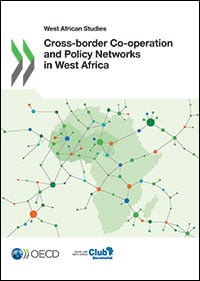 The study | Maps : Part 1 | Maps : Part 2 | Visualise Maps | Online Map Library
The study | Maps : Part 1 | Maps : Part 2 | Visualise Maps | Online Map Library
The following maps are extracted from the OECD publication "Cross-border Co-operation and Policy Networks in West Africa", published in January 2017.
This publication examines how policy actors involved in cross-border co-operation contribute to the regional integration process in West Africa. It uses a pioneering methodology, known as social network analysis, to visualise the formal and informal relationships between actors involved in cross-border policy networks, showing that borders have notable and diverse impacts on exchanges of information and the relative power of networks. The report then analyses a range of regional indicators of co-operation potential, visually demonstrating that borders can also affect the ability of sub-regions within West Africa to develop cross-border initiatives in a number of ways. Combining these two analyses with the perceptions of regional policy makers as to which border areas they consider as priorities for regional integration, the publication concludes with the analytical foundations for more effective place-based policies that can enhance cross-border co-operation in West Africa.
You can copy and paste maps directly from the PowerPoint presentation (Part 1 | Part 2) or download individual maps by making a right click and choosing the option "save image as". You can also explore SWAC maps in different formats by key word, topic or country search on the SWAC Online Map Library.
Maps
- Map 1.1: Evolution of market attractiveness, 1960–2020
- Map 2.1: Administrative regions
- Map 2.2: Regions covered by the OECD publication on cross-border co-operation
- Map 3.1: Regional organisations in Africa
- Map 5.1: Population potential of West African border markets
- Map 5.2: Population potential of Senegambia and western Mali
- Map 5.3: Population potential of eastern Guinea
- Map 5.4: Population potential of southern Mali
- Map 5.5: Population potential, border areas of Burkina Faso, Côte d’Ivoire and Ghana
- Map 5.6: Population potential of northern Togo
- Map 5.7: Population potential of southern Togo-Ghana and southwest Nigeria
- Map 5.8: Population potential, border areas of Benin and Nigeria
- Map 5.9: Population potential, border areas of Benin, Niger and Nigeria
- Map 5.10: Population potential of Lake Chad and northeast Nigeria
- Map 5.11: Population potential by border market
- Map 5.12: Population potential, border areas of Cameroon, Chad and Niger
- Map 5.13: Population potential of Senegambia
- Map 5.14: Population potential of eastern Guinea
- Map 5.15: Population potential of southern Mali
- Map 5.16: Population potential of the Ghana-Côte d’Ivoire border
- Map 5.17: Population potential of northern Togo
- Map 5.18: Population potential of southwest Nigeria
- Map 5.19: Population potential of Borgou, Benin-Nigeria
- Map 5.20: Population potential of northern Nigeria
- Map 5.21: Population potential of Lake Chad
- Map 5.22: Surface watercourses in Africa
- Map 5.23: Cross-border catchment basins in West Africa
- Map 5.24: Main aquifers in West Africa
- Map 5.25: Export crops and pastoralism
- Map 5.26: West Africa’s cotton zones, ginning factories and exports
- Map 5.27: Grain production basins
- Map 5.28: Vernacular languages in West Africa
- Map 5.29: Vehicular languages in West Africa
- Map 5.30: Political violence, 2003–15
- Map 5.31: Market activity and attack sites in northeastern Nigeria, 2014–15
- Map 5.32: Regional poverty rates and border discontinuities
- Map 5.33: Cross-border co-operation potential: Population
- Map 5.34: Cross-border co-operation potential: Water resources
- Map 5.35: Cross-border co-operation potential: Agricultural and pastoralism
- Map 5.36: Cross-border co-operation potential: Languages
- Map 5.37: Cross-border co-operation potential: Status of border
- Map 5.38: Cross-border co-operation potential: Political stability
- Map 5.39: Cross-border co-operation potential: Poverty
- Map 5.40: Cross-border co-operation potential
- Map 6.1: Regional organisations of the Senegal River, Liptako-Gourma and Lake Chad
- Map 7.1: Spatialisation of the regional information network
- Map 7.2: Spatialisation of the information network of the Senegal River region
- Map 7.3: Spatialisation of the information network in the Liptako-Gourma region
- Map 7.4: Spatialisation of the information network in the Lake Chad region
- Map 8.1: Mental maps of the region
- Map 8.2: Mental maps by locality
- Map 8.3: Centre of gravity, standard distance and standard deviational ellipses
- Map 8.4: Priority areas for cross-border co-operation in West Africa
- Map 8.5: Priority area for cross-border co-operation in the Senegal River region
- Map 8.6: Priority area for cross-border co-operation in Liptako-Gourma
- Map 8.7: Priority area for cross-border co-operation in the Lake Chad region
- Map 8.8: Strategic areas for cross-border co-operation at the regional level
- Map 8.9: Strategic areas for cross-border co-operation at the local level
Settlement, Market and Food Security
The study | Maps | Figures | Visualise Maps | Online Map Library
The following maps are extracted from the OECD publication "Settlement, Market and Food Security", published in May 2013.
Settlement dynamics have been reshaping West Africa’s social and economic geography. These spatial transformations – high urbanisation and economic concentration – favour the development of market-oriented agriculture. With the population of West Africa set to double by 2050, agricultural production systems will undergo far-reaching transformations. To support these transformations, policies need to be spatially targeted, improve availability of market information and broaden the field of food security to policy domains beyond agriculture. They need to rely on homogeneous and reliable data – not available at present – particularly for key variables such as non-agricultural and agricultural population, marketed production and regional trade.
You can copy and paste maps directly from the PowerPoint presentation or download individual maps by making a right click and choosing the option "save image as". You can also explore all SWAC maps in different formats by key word, topic or country search on the SWAC Online Map Library.
Maps
- Map 1.1: Rural density, 2000
- Map 1.2: Food emergencies in Africa, 1980–2011
- Map 3.1: West African migration flows just after the period of independence
- Map 3.2: Towns, cities and traffic corridors
- Map 3.3: GSM coverage in West Africa, 2006
- Map 3.4: Geographical transformation and territorial redistribution of migration
- Map 3.5: Urban network and growth of towns and cities
- Map 3.6: Rural density and urban network in West Africa, 2010
- Map 3.7: Trends in the non-agricultural/agricultural population ratio (NAP/AP), 1950-1980-2010
- Map 4.1: Density, distance and division
- Map 4.2: Constraints to private investment in agriculture in Nigeria
- Map 4.3: Main production zones
- Map 4.4: Marketed surplus production of maize, 2007
- Map 4.5: Urban maize consumption basins, 2007
- Map 4.6: Regional maize flows
- Map 6.1: Trends in the non-agricultural/agricultural population ratio, 2025-2050
Figures
- Figure 1.1: Illustration of settlement dynamics, 1950–2010
- Figure 1.2: Demographic transition and West Africa countries, 2009
- Figure 1.3: Urban and rural population growth rates
- Figure 1.4: Composition of urban growth
- Figure 1.5: Number of urban agglomerations with more than 20 000 inhabitants
- Figure 1.6: Agricultural performance, 1980–2010
- Figure 1.7: Food supply from domestic production
- Figure 1.8: Imports and exports of food and animals
- Figure 1.9: Share of imports in total food availability
- Figure 1.10: Imports of rice and wheat
- Figure 1.11: Harvested area, yields and labour productivity
- Figure 1.12: Prevalence of undernourishment
- Figure 1.13: Status and progress in undernourishment: 1990–92 to 2006–08
- Figure 1.14: Global Hunger Index
- Figure 1.15: Hunger situation in West Africa
- Figure 1.16: Number and causes of food crises – CILSS and West Africa
- Figure 1.17: Slow- and sudden-onset natural disasters in West Africa
- Figure 1.18: Components of Cabo Verde’s index of vulnerability
- Figure 2.1: Settlement dynamics in Nigeria – intermediate results
- Figure 2.2: GDP growth and the pace of urbanisation, 1970–2000
- Figure 2.3: Settlement dynamics in West Africa
- Figure 3.1: Distribution of urban settlements, 1950–2010
- Figure 3.2: Total, rural and urban population
- Figure 3.3: Rural and agricultural population in Nigeria
- Figure 3.4: Urban/rural (U/R) and non-agricultural/agricultural population (NAP/AP) ratio for 163 countries, 2000
- Figure 3.5: Informal production units by sector, 2003
- Figure 3.6: Informal economy contribution to GDP, 2000
- Figure 3.7: Food security by environment, Niger
- Figure 4.1: Share of market expenditure in total food expenditure
- Figure 4.2: Rural accessibility index and road density per hectare of cultivated land
- Figure 4.3: Trade in main cereals according to the FAO
- Figure 4.4: Evolution of production and availability of maize in Benin
- Figure 4.5: Maize production in West Africa, 1980-2010
- Figure 4.6: Production, domestic availability and food availability at the regional level, 2007
- Figure 4.7: Non-food utilisation as a share of maize production
- Figure 4.8: Production, auto-consumption and marketed surplus, 2007
- Figure 4.9: Maize production and marketed surpluses
- Figure 4.10: Regional urban consumption shares by country, 2007
- Figure 5.1: Population in West Africa 1950-2050
- Figure 5.2: Level of urbanisation and fertility rates, 2005–10
- Figure 5.3: Birth and death rates in West Africa
- Figure 6.1: Projection of agricultural and non-agricultural population
- Figure 6.2: Permanent meadows and pastures, 2009
- Figure 6.3: Trends in agricultural production (in kcal), cultivated area and harvested area
- Figure 6.4: Growth in production by factor
- Figure 6.5: Distribution of landholding sizes, Côte d’Ivoire and Senegal

